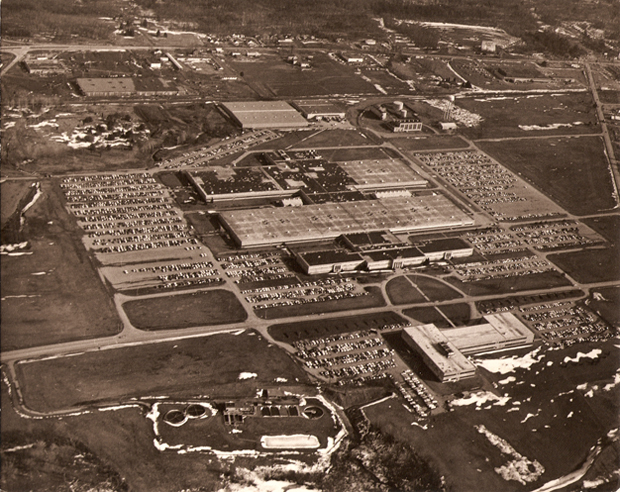

Top photo: IBM Family Day, 1958
Lower photo: IBM Plant Photo, 1966
Kingston—The IBM Years, the Friends’ most ambitious annual exhibition ever, will spotlight some of IBM’s signature achievements during its 40-year stay in Ulster County, including the SAGE air defense system and System/360 mainframe, but with an equal focus on the people who worked for the computer giant and the lives and neighborhoods they created for themselves locally.
The exhibition will be installed in The Friends of Historic Kingston’s Gallery, at Wall and Main streets, from May 2 to October 31, 2014. Gallery hours are Friday and Saturday, 11am to 4pm. Admission is free.
“Our IBM project has taken us in exciting new directions,” said Jane Kellar, executive director of Friends of Historic Kingston. “We’ve broadened our focus to include 20th-century industrial history and suburban neighborhoods that have never received scholarly attention. Scores of people have helped with the research and have generously lent their memorabilia.”
Under the direction of Prof. Roger Panetta of Fordham University, Friends volunteers recorded more than 50 oral histories of people in the community, including “IBMers” themselves and others who did business with IBM.
“For those who did not work at the Kingston plant, the exhibition will be a fascinating education about one of America’s most successful and nurturing corporations,” said Ward Mintz, a Friends board member and veteran museum curator who directed the project. “It will also be a reminder of the extensive development that took place in Ulster County starting in the 1950s.”
The exhibit will include one of the earliest electric typewriters produced in Kingston, and rare vintage photographs of the SAGE project, the testing floor for the System/360 mainframe and the typewriter assembly line. IBMers have lent their employee badges and scrapbooks filled with memories of promotions, work dinners and off-site training. Items on loan from IBM include an original whiteboard with the words “THE END IS HERE” affixed by an anonymous employee after the plant’s shutdown was announced.
Also included in the exhibit will be new photographs, commissioned from Hudson Valley photographer Stephen Benson, of post-World War II residential, commercial, civic and religious structures, from Cape-style houses in Whittier in Ulster Landing to ranch houses in Rolling Meadows in Hurley, plus Kingston’s Temple Emanuel on Albany Avenue and the M. Clifford Miller Junior High School in Lake Katrine.
An illustrated book, co-published with Black Dome Press, accompanies the exhibition. It includes a preface by Mintz, the project director, and essays by some of the Hudson Valley’s most illustrious scholars, including Panetta, Harvey Flad, co-author of Main Street to Mainframes: Landscape and Social Change in Poughkeepsie; and William B. Rhoads, author of Ulster County, New York, The Architectural History and Guide. Gail Godwin, author of fifteen novels and three-time National Book Award finalist has contributed an essay with illustrations by award-winning architect, Frances Halsband. The book also includes essays by Lowell Thing, a retired IBM technical writer and author of the forthcoming Kingston history, The Street That Built a City; George G. Washington, a retired IBM engineer; and newspaper columnist Hugh Reynolds. The book, with 150 illustrations, many in color, will retail for $25.95.
A full schedule of public programs accompanies the exhibition, beginning with a lecture by guest scholar Roger Panetta about IBM and the modernization of Kingston on April 27 at 2:00, the Friends Annual Meeting at the Kirkland, Main and Clinton Streets in Kingston. The public is invited. Additional Friday Conversations will feature a host of other speakers. Check the EVENTS page for details.
Kingston—The IBM Years was made possible with support from the Architecture, Planning and Design Program of the New York State Council on the Arts, with the support of Governor Andrew Cuomo and the New York State Legislature; the County of Ulster’s Ulster County Cultural Services & Promotion Fund administered by Arts Mid-Hudson; Furthermore: a program of the J. M. Kaplan Fund; the Mid-Hudson Valley Federal Credit Union; the New York Council for the Humanities; and three anonymous donors.
